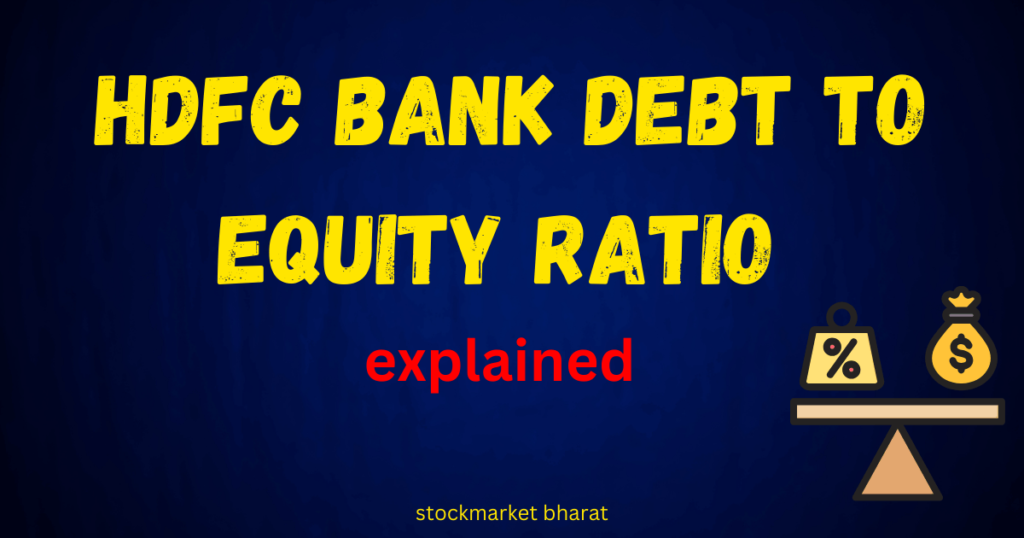HDFC BANK DEBT TO EQUITY RATIO
Understanding HDFC Bank’s Debt to Equity Ratio: A Key Financial Metric
When analyzing the financial health of a bank, one of the most crucial metrics investors and analysts consider is the debt to equity ratio. For HDFC Bank, one of India’s largest private sector banks, this ratio provides insights into its financial leverage, stability, and risk exposure. In this blog, we will explore what the debt to equity ratio means, how HDFC Bank compares to its peers, and why this metric is important for investors.

What Is the Debt to Equity Ratio?
The debt to equity (D/E) ratio is a key financial indicator that measures the proportion of a company’s total debt relative to its shareholder equity. The formula for calculating the ratio is:
Debt to Equity Ratio=Total DebtTotal Shareholder Equity\text{Debt to Equity Ratio} = \frac{\text{Total Debt}}{\text{Total Shareholder Equity}}
For banks like HDFC Bank, this ratio helps assess their reliance on borrowed funds versus their own capital to finance operations and growth.
Importance of Debt to Equity Ratio in the Banking Sector
- Measures Financial Leverage: A high D/E ratio suggests that a bank is relying more on borrowed capital, which can increase financial risk.
- Indicates Risk Exposure: A lower ratio signifies a more stable capital structure, reducing the chances of financial distress.
- Helps in Investment Decisions: Investors use this metric to determine whether a bank is managing its capital efficiently.
- Comparison with Industry Peers: Understanding how a bank compares to others in the industry helps in evaluating its financial standing.
HDFC Bank’s Debt to Equity Ratio: A Financial Analysis
HDFC Bank is known for its strong balance sheet and efficient capital management. The bank operates under strict regulatory frameworks set by the Reserve Bank of India (RBI), ensuring financial stability and adequate capital reserves.
Current Debt to Equity Ratio of HDFC Bank
(Since financial data frequently changes, please check the latest reports for updated figures.)
- As per the latest available financial statements, HDFC Bank’s debt to equity ratio stands at approximately 10.8.
- This ratio indicates that HDFC Bank has a moderate reliance on debt, which is normal for banks given their business model.
- Compared to public sector banks like SBI, HDFC Bank maintains a more balanced debt structure, ensuring long-term stability.
Why HDFC Bank’s Debt to Equity Ratio Matters for Investors
1. Strong Capital Position
- HDFC Bank has a well-managed capital structure, reducing financial risks.
- The bank maintains sufficient equity to handle economic downturns effectively.
2. Loan Portfolio Management
- HDFC Bank’s loan book includes corporate loans, retail loans, and SME loans, influencing its debt levels.
- A diversified loan portfolio ensures steady revenue but requires prudent risk management.
3. Comparison with Other Banks
- HDFC Bank’s debt to equity ratio is lower than SBI but slightly higher than ICICI Bank.
- This balanced approach to leveraging debt makes HDFC Bank a reliable option for investors.
Comparing HDFC Bank’s Debt to Equity Ratio with Peers
| Bank | Debt to Equity Ratio (Latest) |
|---|---|
| HDFC Bank | 10.8 |
| SBI | 12.5 |
| ICICI Bank | 11.2 |
| Axis Bank | 9.7 |
(Please verify the latest numbers before making investment decisions.)
Factors Affecting HDFC Bank’s Debt to Equity Ratio
Several factors influence the debt to equity ratio of HDFC Bank:
- Economic Conditions: A recession or financial crisis can impact loan recoverability and increase debt levels.
- RBI Regulations: Banking regulations dictate how much capital a bank must hold relative to its debt.
- Non-Performing Assets (NPAs): High NPAs can affect financial health and increase risk.
- Interest Rate Fluctuations: Changes in interest rates impact borrowing costs and financial leverage.
- Government and RBI Policies: Regulations surrounding banking operations influence debt management strategies.
Should You Invest in HDFC Bank Based on Its Debt to Equity Ratio?
Pros of Investing in HDFC Bank
✔ Strong financial position with balanced leverage ✔ High profitability and consistent growth ✔ Well-regulated and efficiently managed operations ✔ Attractive for long-term investors
Cons of Investing in HDFC Bank
❌ Moderate reliance on debt financing ❌ Impact of economic downturns on loan recoverability ❌ Competition from other private banks
Final Thoughts
HDFC Bank’s debt to equity ratio is a crucial financial indicator that reflects its financial strength and risk exposure. With a well-managed debt structure, the bank remains a solid investment choice in the Indian banking sector. However, investors should also consider economic conditions, regulatory changes, and loan performance before making investment decisions.
For further insights on financial metrics, check out this detailed guide on financial leverage.
Disclaimer: This article is for informational purposes only and should not be considered financial advice. Please consult a professional financial advisor before making investment decisions.
WORTH A READ:sbi-debt-to-equity-ratio